Sustainability/Green
Power Pole EV Charging Points
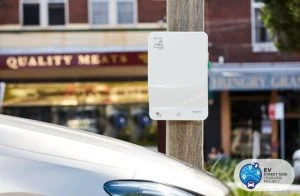
It is easy enough to transform your garage into a recharging point for your new electric vehicle (EV). There are other public recharging points around many of our main towns and cities now that are easily accessible. So, for a large number of relatively new EV owners, life is relatively straightforward when it comes to having to top up their EV with power. But what happens for those EV owners who live in an apartment that has no off-street parking or garaging for their car?
New commercial recharging stations of various types and in various situations are beginning to appear in Australia’s larger cities and their adjacent suburbs. You can find EV recharging points located at public buildings, service stations, kiosks, shopping centres, and even in an EV owner’s garage. The number and need for EV charging points is expected to undergo exponential growth as the demand for such recharging facilities grows along with uptake of EVs. Currently, one in four Australian households do not have off street parking. EV ownership for these people is a less attractive proposition. There is a need, therefore, to provide easy access to a recharging point for households who don’t have access to off street parking.
An Australian- and New Zealand-based utility services company called The Intellihub Group is in the business of providing innovative power metering and power data solutions to maximise digital and new energy services. One of the interesting projects that they currently on-the-go is providing power pole recharging for EVs. This is a perfect solution for the one in four households with no access to off street parking.
Intellihub is in the process of using local power poles in a trial for street-side recharging points, particularly catering to these less fortunate EV owners. According to Intellihub, there are significant gains to be made in the provision of these power pole recharging facilities for EV owners. Not only will the trial provide easy power access, but it will also help to understand the impact of EV chargers on the electricity network. Researchers will monitor how many people use the chargers during the trial and their impact on the electricity network.
Via the Australian Renewable Energy Agency (ARENA), $871,000 of Australian Government support has been given to Intellihub. Intellihub has contracted the first deployment of 50 EV chargers to be installed on street side power poles for a group of EV owners without off-street parking. These lucky EV owners live throughout New South Wales in either apartments, townhouses or units without any direct localized access to EV charging on-site.
The power pole project is a trial valued at $2.04 million, so it is also supported by Schneider Electric, the providers of the EV charging infrastructure and Electric Vehicle Supply Equipment (EVSE). Schneider Electric will manage the charging service for the trial. Origin Energy will ensure that 100% of all the energy required to charge the EVs in the trial project will be matched with the equivalent amount of certified renewable energy resources that will be added to the grid.
The idea of power pole charging an EV is not a uniquely Australian concept. Power pole charging is already being rolled out across the world. Some major global cities, including London, Toronto, Los Angeles, New York, and Hamburg are installing tens of thousands of power pole or streetlight EV chargers.
Power pole charging an EV in a city/town environment seems a rather straightforward solution to making living with an EV a whole lot easier. Intellihub CEO Wes Ballantine said: “It’s expected that as many as 10 per cent of new car sales in Australia will be electric vehicles by 2025. That equates to an extra 120,000 new EVs on our local streets each year. It’s likely that many of these car owners may be unable to charge their EVs from home. Power poles line most of our public streets and that presents an opportunity for the EV charging market. They’re an accessible, safe, and practical option for EV charging.”
The EV owners will use a third-party app to manage their recharging service. They will be able to get information about charging costs, time limits, billing, and other tools for interfacing with the electricity grid.
This is a big step towards a practical recharging infrastructure across Australia. It seems that owning an EV in a congested city/town environment might be getting a whole lot easier.
Understanding Current Hybrid Vehicle Technology
So, what is a hybrid car in 2022? What is the current technology ?
A hybrid vehicle combines at least one electric motor with an internal combustion engine (ICE) to move the car. This system is set up to recapture any energy from regenerative braking. There will be times when the electric motor can do all the all the work of moving the car, and then sometimes the ICE will do 100% of all the work. And then there will be times when the electric motor and the ICE work together to move the vehicle along.
The hybrid system ultimately has the end result of less fuel being burned and, therefore, offering its driver better fuel economy. In some circumstances, like in a short quick passing manoeuvre, adding electric power to the ICE power will can even boost the vehicle’s performance for performing the task.
All hybrid systems are set up for the electric motor to use electricity coming from a high-voltage battery pack. This battery pack is separate from the car’s conventional 12-volt battery system that runs the auxiliary car systems (e.g., air conditioning, headlights, coolant fan, etc.). The high voltage battery pack is replenished by capturing energy from deceleration (typically this energy is lost to heat that is generated by the brakes in a conventional ICE-only vehicle). So, the regenerative braking system captures this deceleration energy and sends it back to the high voltage battery pack which runs the vehicle’s electric motor. Hybrid vehicles are also designed to use the ICE to charge and maintain the high voltage battery pack.
The main Hybrid Designs are:
Parallel Hybrid
The electric motor(s) and ICE are connected in a common transmission (automatic, manual, or a CVT) that will blend the two sources of power for moving the vehicle.

Series Hybrid
A Series Hybrid is where the electric motor(s) provide all the thrust, and there is never a physical or mechanical connection between the ICE and the wheels. The ICE is purely onboard for recharging the high voltage battery pack.

Plug-In Hybrid (PHEV)
The plug-in hybrid system enhances the conventional hybrid concept with a much larger high voltage battery pack. As this is similar to a conventional electric vehicle (EV), it must be fully recharged using an external electricity source (i.e., charged from your home power supply, your office, or a public charging station). Because the energy storage is much greater, it allows for extended all-electric driving, thus significantly reducing your fuel consumption. In fact, short commutes and a recharge nightly means that you’ll be running on electricity most of the time (great for city driving). Should you deplete the large battery pack, the car simply reverts to being a conventional parallel hybrid, using the assistance of an ICE. Plug-in hybrids can be either a series or a parallel hybrid system.

Mild Hybrids
When you hear the term Mild Hybrid, don’t start thinking it is anything like the Parallel Hybrid, Series Hybrid, or Plug-In Hybrid (these 3 are considered “full hybrids”) mentioned above. In a Mild Hybrid vehicle, the electric motor is there to only assist the ICE for the purposes of improving fuel economy, increasing performance, or both. It won’t ever fully move the vehicle on its own.

The Lithium Rush

Lithium is in very hot demand at present. Like a new frenetic modern-day gold rush, it seems that big companies wanting lithium are frantically looking for this new sort of gold.
Obviously, lithium is required in the production of lithium-ion battery cells that are used for powering EVs. In order to make sure that they don’t run short of lithium anytime soon, China, which has the largest EV market in the world, produces 80% of the world’s usable lithium product all on their own. In a statement recently, Sung Choi, a metals analyst, stated that “The cost of lithium has risen because virtually all automakers have jumped onto producing EVs.”
Currently, over half of the world’s lithium resources are in South America and Australia. As prices for lithium are surging – and some metal analysts at BloombergNEF (BNEF) have witnessed an almost 500% increase in the past year – China seems to be leading the charge in the hunt for new lithium mining reserves.
China is searching around the world for new lithium deposits that can supply their big need for the metal used in EV production. China has even looked at the Qinghai-Tibetan plateau as a source for the metal, as well as in Africa. Sung Choi also said that “Africa has recently been in the spotlight with its ample resources in metals.”
Some of the African lithium mining fields being looked at by China include the reserves found in the Democratic Republic of Congo, where Zijin, a Chinese mining giant, is battling with Australia’s AVZ minerals over controlling the DRC’s Manono mine. Quite possibly, the Manono mine has the world’s biggest lithium deposit.
Last year, Congolese President Félix Tshisekedi said that people living in areas with mines were “still languishing in misery,” while it was the foreign multinationals running the mines who prospered. The mines do provide locals with jobs, but many would say that the locals don’t see enough trickle-down reward from the massive multimillion-dollar projects.
Also, in Zimbabwe there are large untapped deposits of lithium, and China is rapidly buying up these resources. Zhejiang Huayou Cobalt, a Chinese-based company, has recently purchased Arcadia Lithium mine outside Harare. The money (some $300 million) will be used to construct a mining plant with a processing capacity of 400,000 metric tons of lithium concentrate per year. The Zimbabwean government has welcomed this recent investment, looking forward to helping fill China’s and the EV’s need for lithium-based batteries.

The current and potential growth of the EV industry, and therefore the rush for new lithium resources, has had companies like Tesla seriously considering getting into lithium mining and refining directly for themselves. Maybe it is Toyota who is taking the more manageable approach to the mass production of EVs. Their pace toward an EV transfer seems to take a better-calculated methodology when compared with some other big automotive manufacturers who seem driven on producing a fleet of their own EVs as fast as possible. Toyota sees the value in hybrid technology building a bridge to solving any issues around climate change and the EV mindset.
Lithium isn’t just used in the production of EV battery packs. Lithium is also used in rechargeable batteries for mobile phones, laptops, digital cameras, and in warfare equipment. It is also used in some non-rechargeable batteries for things like heart pacemakers, clocks, and toys. The future and the course of EV production and EV uptake does seem to depend on the amount of lithium being available and the costs involved for mining it. These costs will affect how much a new climate change-solving EV might eventually sell for.
New Cars to Buy – Exciting!
Along with the new SUVs showcased last time, Australia will also see some other exciting vehicles arriving in the coming months. Keep your eyes out for the following:
Honda
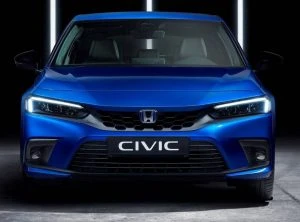
Civic Hybrid
Honda’s new Civic hybrid has its own subtle design features that set it apart from other Civic models. Hybrid-specific displays for the infotainment screen and instrument cluster gives the car its own environmentally friendly twist, plus the revised rear bumper is designed to conceal the exhaust outlets. Honda’s Civic Hybrid also gets blue accents for its Honda badges, and there is a special e:HEV tailgate badging to set it off nicely.
As a driver, the new Honda Civic Hybrid is an impressively competent vehicle with great economy and plenty of get up and go. The Civic HEV’s hybrid system is based around the 2.0-litre naturally-aspirated Atkinson-cycle petrol motor that is found in the current Honda Accord VTi-LX Hybrid. Matching the engine output to a smooth CVT automatic makes for an excellent easy car to drive. 315 Nm of torque provides grunt when you need it and the 135 kW of peak power suits this car well and delivers a bigger punch than the standard Civic’s 131 kW/240 Nm levels.
The front-wheel drive Honda Civic Hybrid is likely to be more efficient than the Accord Hybrid and even more so than Toyota’s Corolla Hybrid (4.2 litres/100 km).
BYD
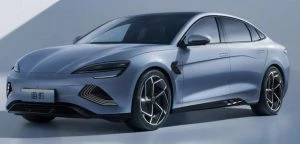
BYD Atto 4
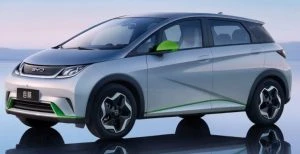
BYD EA 1 (Dolphin)
BYD Auto is the largest EV manufacturer in the world and is the automotive division of the Chinese multinational manufacturer BYD Company. Along with some SUV models, BYD is also bringing their Atto 4 sedan and their neat little EA 1 to Australia.
The BYD Atto 4 is a mid-size sedan that looks beautiful, sporty, and aerodynamic. Equipped with loads of the latest technology and also obtaining power from large batteries with a unique design, the Atto 4 impresses. Standard Atto 4 versions get a 61.4 kWh battery pack and a claimed 550 km range. The pricier models get a larger 82.5 kWh unique Blade battery with a claimed range of up to 700 km. Having the larger battery and an AWD system, this flagship BYD Atto 4 can reach 100km/h from a standstill in just 3.8 seconds!
More BYD excitement has the imminent arrival of the BYD EA 1 Hatchback. In China they call the BYD EA 1 the rather endearing name ‘BYD Dolphin’. This is a small Chinese EV hatchback that is being picked to be priced at or less than $30,000 in Australia. The small all-electric hatchback will be available with various battery and drivetrain configurations, all using a single electric motor to power the front wheels.
Two battery capacities: 30.7 kWh or 44.9 kWh will be available for the EA 1, both of which can be paired with a 70 kW/180 Nm motor. The larger 44.9 kWh battery can also be linked to a 130 kW/290 Nm motor, providing swifter acceleration and cruising speeds. Larger batteries will also become available over time for the little EA1 – particularly necessary, as Australia is a pretty vast land mass.
Managing director, Luke Todd, stated that “Our view is [that] in Australia any EV must have a minimum – even for city running – of 400 km to be accepted in the Australian market. All of our vehicles will have at least a 400 km range … our target is 500 km-plus.”
Cupra
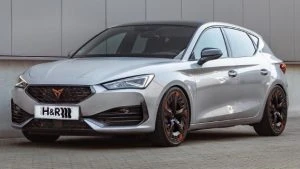
Cupra Leon
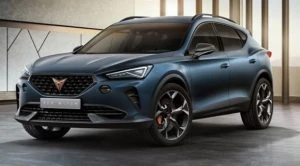
Cupra Formentor
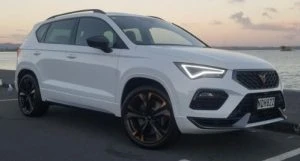
Cupra Ateca
Cupra is a Volkswagen-owned Spanish brand who have opened their doors to import their vehicles to Australia, offering us a 3-strong model range.
The exciting range of Cupra cars – Ateca (SUV), Leon (Hatchback), and Formentor (Crossover) – will spearhead the Australian line-up.
The Cupra Ateca SUV comes exclusively in the VZx form, so 221 kW of power and 400 Nm of torque is sent through the 4Drive AWD system to deliver 0-100 km/h in 4.9-seconds. I can see plenty of performance-SUV lovers who want to drive something as unique looking as the Cupra Ateca SUV wanting one!
The Cupra Leon Hatchback will be offered in VZ, VZe and VZx specification levels. So along with plenty of technology and differing variants, there will be a 2.0-litre turbo 140 kW/320 Nm, 180 kW/370 Nm, 180kW/400 Nm (Hybrid), and 221 kW/ 400Nm outputs respectively. So, there’s something for everyone here!
The Cupra Formentor is the Crossover Cupra and boasts the 4Drive AWD system on the V and VZx variants. Note the gorgeous crossover body styling that brings with it plenty of space, practicality and comfort.
All new Cupras sold in Australia will include a 5-year, unlimited kilometre warranty.
Volvo
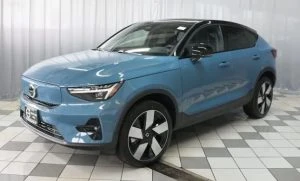
Volvo C40
Volvo has a new C40 coming! There are two versions offered that are based around one having a single electric motor and the other a dual electric motor layout. The Volvo C40 shares the electric powertrains with the XC40. Boot space is measured at 413 litres for both the single and dual motor versions.
Volvo’s the single motor C40 uses a 69 kWh battery pack and a single electric motor over the front axle. It produces 170 kW of power and 330 Nm of torque, combining nicely to provide drivers with a potential 0-100km/h dash being finished in 7.4 seconds. A full charge has a range of over 400 km.
Jump over to the Volvo C40 with its dual motor system, and you’ll find a larger 78 kWh battery pack. An electric motor for the front axle and an electric motor for the rear axle has this Volvo C40 equipped with AWD and capable of seeing off the 0-100km/h sprint in a claimed 4.7 seconds. That’s pretty swift! Again, a full charge should be able to take you over 400 km.
The single motor Volvo C40 kicks off at around $74,990, and the dual motor model around $82,490.
Audi
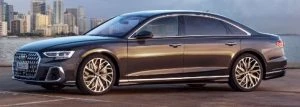
Audi A8
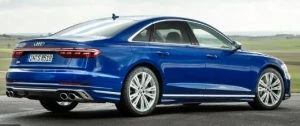
Audi S8
Audi’s A8 and S8 facelifts are coming. The A8 Sedan and Audi’s sportier S8 version have been a stunning proposition for some time, and they keep getting better. Quite an attractive large and luxurious sedan, the 2022 A8 delivers new levels of technology in the areas of comfort, entertainment, and safety.
The stunning A8 exterior remains similar to the outgoing model but you will find some nice subtle changes on the outside. 18–21-inch rims are available with six new designs to choose from. Audi’s ‘singleframe’ grille has been widened and pushed out at the bottom corners for a sportier, more athletic appearance.
The luxury sedan has grown a bit longer, making Audi’s flagship even more comfortable. It competes with the best big sedans from Mercedes Benz, BMW, and Lexus, so the relaxation seat package comes as no surprise, adding a back massage function, a foot warmer, an optional centre control console, and a fold-out table. 23 Bang and Olufsen speakers create an amazing audio sound.
Around the world, the new Audi A8 and A8 L versions will offer a wide selection of chiefly twin-turbo V6 engines that have 48-volt mild-hybrid assistance. All models will boast Quattro AWD and an 8-speed automatic. Audi S8 versions get the sweet-singing twin-turbo 4.0-litre V8 petrol ICE that can move this luxury–sports sedan from 0-100km/h in just 3.8 seconds. Boasting all-wheel steering, the S8 is a nimble thing of beauty.
Citroen
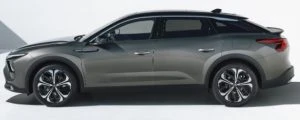
Citroen C5 X
Citroen calls the C5 X a “unique combination of the elegance of a sedan, the dynamism of a wagon and the elevated stance of an SUV”.
In my eyes, the new Citroen C5X looks both elegant and comfortable – just like a special Citroen should. The Citroen C5 X is a large 5-seater that measures 4805 mm in length. Luggage capacity is 485/1580 litres for the PHEV version and 545/1640 litres for the ICE car. Inside its cabin, you’ll find the C5 X is very comfortable, and the sensible interior layout is pleasant on the eye. A load of high-tech interior features include a digital driver’s display, a big 12.0-inch central touchscreen, Android Auto, Apple CarPlay, and a novel toggle gear shifter.
Adaptive dampers increase the Citroen C5 X’s ability out on the road, ensuring that those of us who love comfort can ride all day in a C5 X, all very comfortably indeed.
Equipped with the 165 kW/300 Nm 1.6-litre turbo-petrol four-cylinder ICE, the Australian version will have decent power (0-100 km/h in 8.8 seconds) while being hooked up to an 8-speed automatic transmission and FWD. A top speed of 232 km/h is doable. Citroen’s Australian importer is also considering launching the new Citroen C5 X with a PHEV powertrain. This system mates the 1.6-litre turbo ICE with an 81.2 kW electric motor and a 12.4 kWh lithium-ion battery for a total system output of 165 kW and a claimed electric range of 50 km (WLTP). The PHEV version is slightly quicker, boasting a 7.9 second time for the 0-100 km/h dash.
Peugeot
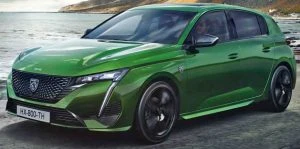
Peugeot 308
Peugeot is bringing us the next-generation 308 and the 3rd generation 308 is a classy looker from any angle you care to look at it from the curb side. Peugeot’s Australian line-up will consist of 4 variants: the 308 GT Hatch, 308 GT Premium Hatch and Wagon, and the Peugeot 308 GT Sport PHEV hatch – a plug-in hybrid (PHEV).
The PHEV versions of the 308 Hatch and Wagon will use larger batteries and more powerful motors than you’ll find in the smaller Peugeot e-208 supermini models. A Peugeot 308 GT Sport PHEV model sees a 132 kW 1.6-litre turbocharged 4-cylinder ICE unit paired to an 81 kW electric motor. The total output of the powertrain sends out a sprightly 165 kW of power and 360 Nm of torque to an AWD system for maximum traction and plenty of excitement.
New 308s with ICEs will be powered by a 1.2-litre turbocharged 3-cylinder petrol engine that produces 96 kW of power and 230 Nm of torque. This little engine is paired with an Aisin-sourced 8-speed automatic transmission that sends the power to the front wheels. Peugeot offers an e-308 in Europe, which is a pure electric variant.
Ford
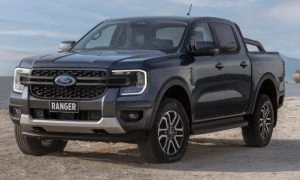
Ford Ranger Ute
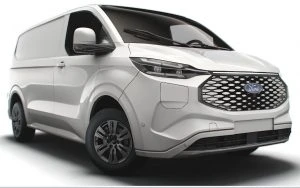
Ford E Transit
The new Ford Ranger Ute is packed with smart functionality and a cool ‘Tonka Toy’ appearance. Commands via voice, phone, or the central touchscreen has you controlling many of the infotainment features. Wireless phone charging, a smart climate control system, and a new digital cluster for the driver keeps the tough new Ford Ranger models at the head of the pack. Its chunkier styling with a wider stance, big towing capacity, and superior off-road ability are part of the new Ford Ranger experience.
Like the brand new Ford Everest SUV, the Ranger Ute houses the latest 3.0-litre turbo diesel V6 ICE, which is also offered alongside the existing 2.0-litre twin-turbo 4-cylinder diesel engine for 2022/23. The V6 boasts 184 kW of power at 3250 rpm and 600 Nm of torque from 1750-2250 rpm.
Ford’s latest E-Transit vans will be available with an all-electric powertrain for more efficient, zero-emissions driving.
Genesis
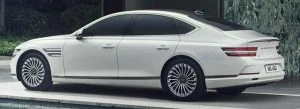
Genesis G80 Sedan
The charming Genesis G80 Sedan has gone pure EV and it is a stunner on the styling front. The car’s opulence and quiet ride will impress. An 87.2 kWh lithium-ion battery pack is housed under the floor, and a claimed Worldwide Harmonised Light Vehicle Test Procedure (WLTP) range of over 500 km is a decent amount of travel. The G80 EV Sedan has a pair of electric motors that work in unison to develop a maximum of 272 kW. This level of power combines with instantaneous torque of up to 700 Nm. These are powerful figures, allowing the luxurious Genesis Sedan to sprint from 0-100 km/h in less than 5 seconds.